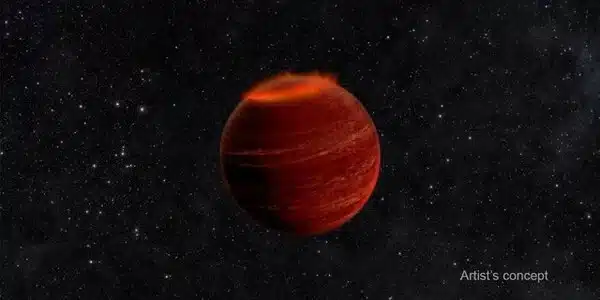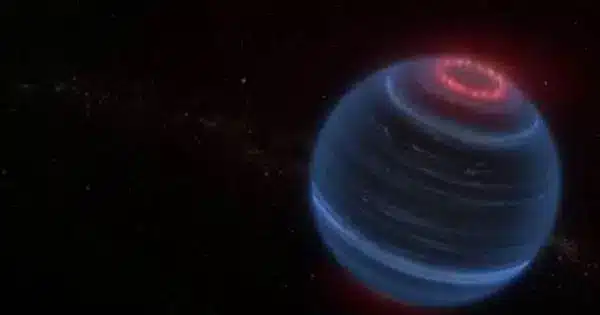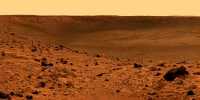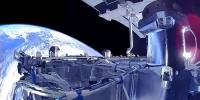Astronomers using NASA’s James Webb Space Telescope discovered a brown dwarf (an object more massive than Jupiter but smaller than a star) emitting infrared light from methane, most likely due to energy in its upper atmosphere. This is a surprise discovery because W1935, the brown dwarf, is cold and lacks a host star, therefore there is no clear source of upper atmospheric energy. The team speculates that the methane emissions are caused by processes that produce aurorae.
These discoveries are being presented at the 243rd meeting of the American Astronomical Society in New Orleans. To assist explain the riddle of infrared emission from methane, the scientists looked to our solar system. Methane emissions are common in gas giants such as Jupiter and Saturn.
Aurorae form on Earth when energetic particles emitted by the Sun are trapped by the planet’s magnetic field. They flow down into our atmosphere along magnetic field lines near Earth’s poles, clashing with gas molecules to form eerie, dancing curtains of light. Jupiter and Saturn have similar auroral processes in which they interact with the solar wind, but they also receive auroral contributions from adjacent active moons such as Io (for Jupiter) and Enceladus (for Saturn).
For isolated brown dwarfs like W1935, the lack of a stellar wind to contribute to the auroral process and explain the extra energy in the upper atmosphere required for methane emission remains a conundrum. The team surmises that either unaccounted internal processes like the atmospheric phenomena of Jupiter and Saturn, or external interactions with either interstellar plasma or a nearby active moon, may help account for the emission.
With W1935, we now have a spectacular extension of a solar system phenomenon without any stellar irradiation to help in the explanation. With Webb, we can really ‘open the hood’ on the chemistry and unpack how similar or different the auroral process may be beyond our solar system.
Jackie Faherty
A Detective Story
The aurorae’s discovery played out like a detective story. A team led by Jackie Faherty, an astronomer at the American Museum of Natural History in New York, was awarded time with the Webb telescope to investigate 12 cold brown dwarfs. Among those were W1935 — an object that was discovered by citizen scientist Dan Caselden, who worked with the Backyard Worlds zooniverse project — and W2220, an object that was discovered using NASA’s Wide Field Infrared Survey Explorer. Webb revealed in exquisite detail that W1935 and W2220 appeared to be near clones of each other in composition. They also shared similar brightness, temperatures, and spectral features of water, ammonia, carbon monoxide, and carbon dioxide. The striking exception was that W1935 showed emission from methane, as opposed to the anticipated absorption feature that was observed toward W2220. This was seen at a distinct infrared wavelength to which Webb is uniquely sensitive.
“We expected to see methane because methane is all over these brown dwarfs. But instead of absorbing light, we saw just the opposite: The methane was glowing. My first thought was, what the heck? Why is methane emission coming out of this object?” said Faherty.

The team used computer models to infer what might be behind the emission. The modeling work showed that W2220 had an expected distribution of energy throughout the atmosphere, getting cooler with increasing altitude. W1935, on the other hand, had a surprising result. The best model favored a temperature inversion, where the atmosphere got warmer with increasing altitude. “This temperature inversion is really puzzling,” said Ben Burningham, a co-author from the University of Hertfordshire in England and lead modeler on the work. “We have seen this kind of phenomenon in planets with a nearby star that can heat the stratosphere, but seeing it in an object with no obvious external heat source is wild.”
Clues from our Solar System
The scientists sought for signs in our own neighborhood, at the planets in our solar system. The gas giant planets can be used as proxies for what is happening in W1935’s atmosphere more than 40 light-years away.
The researchers discovered that temperature inversions are common on planets such as Jupiter and Saturn. There is still work being done to understand the sources of their stratospheric heating, but major theories for the solar system include external heating by aurorae and internal energy transmission from deeper in the atmosphere.
Brown Dwarf Aurora Candidates in Context
This is not the first time an aurora has been used to explain a brown dwarf observation. Astronomers have detected radio emission coming from several warmer brown dwarfs and invoked aurorae as the most likely explanation. Searches were conducted with ground-based telescopes like the Keck Observatory for infrared signatures from these radio-emitting brown dwarfs to further characterize the phenomenon but were inconclusive.
W1935 is the first auroral contender from outside the solar system to emit methane. It is also the coldest auroral contender outside our solar system, with an effective temperature of roughly 400 degrees Fahrenheit (200 degrees Celsius), which is about 600 degrees Fahrenheit higher than Jupiter.
The solar wind is a major contributor to auroral processes in our solar system, with active moons like Io and Enceladus assisting giants such as Jupiter and Saturn. W1935 does not have a companion star, hence a stellar wind cannot contribute to the occurrence. It remains to be seen whether an active moon contributes to W1935’s methane release.
“With W1935, we now have a spectacular extension of a solar system phenomenon without any stellar irradiation to help in the explanation.” Faherty noted. “With Webb, we can really ‘open the hood’ on the chemistry and unpack how similar or different the auroral process may be beyond our solar system,” she added.














